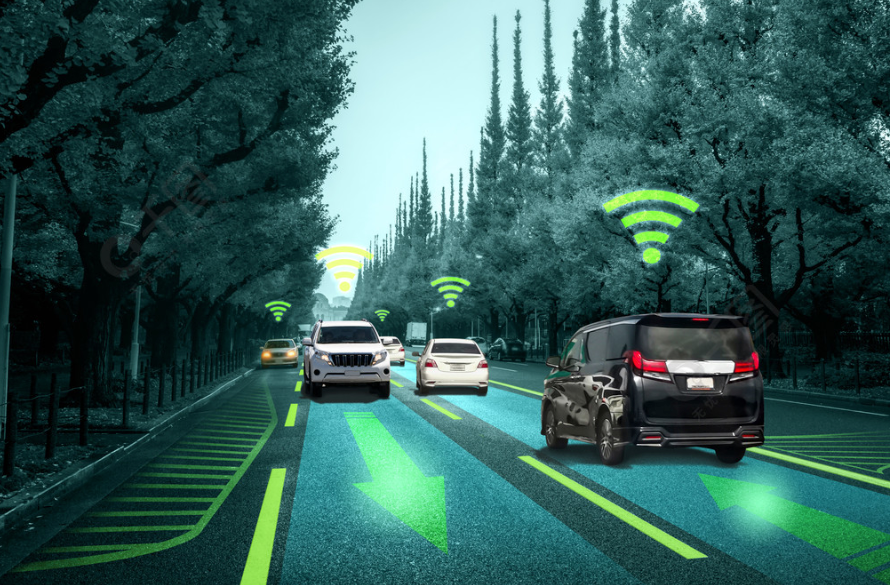The development of automatic driving is in full swing, high-precision positioning combination of navigation is indispensable
Automatic driving requires navigation and positioning systems to provide high-precision and high-reliability navigation information in all-weather all-scenes. Since different sensors and positioning technologies have their own advantages and disadvantages, a single navigation method in the past can no longer meet the requirements, so the current fusion positioning technology based on multi-source data is a major trend.
As we all know, GNSS can provide absolute positioning for vehicles with meter-level accuracy, and differential GNSS can provide absolute positioning for vehicles with centimeter-level accuracy, however, not all road sections can get good GNSS signals at all times. Therefore, in the field of autonomous driving, the output of GNSS generally has to be fused with the IMU, the vehicle's own sensors (e.g., wheel speedometer, steering wheel angle sensor, etc.).
What is IMU-
IMU full name inertial measurement unit, that is, inertial measurement unit, 6-axis IMU is composed of three single-axis accelerometers and three single-axis gyroscopes, accelerometers detect the object in the carrier coordinate system independent of the three-axis acceleration signals, while the gyroscope detects the angular velocity signals of the carrier with respect to the navigation coordinate system, the signals can be processed after the processing, then you can After processing these signals, the attitude of the object is solved.
It is worth noting that the IMU provides a relative positioning information, its role is to measure the route relative to the starting point of the object's movement, so it does not provide information on the specific location of your location, therefore, it is often used in conjunction with the GNSS, when the GNSS signals in some weak places, the IMU can play its role in allowing the car to continue to get the absolute position information, not to "lost". Not to be "lost".
Since 2020, various OEMs have launched more than 20 models equipped with high-precision positioning technology, such as Xiaopeng P5/P7, Ideal One/L9, Zhiji L7, Azure ET7, Nezha U Pro, Eaan V Plus/LX Plus, Great Wall Mokka, BAIC Extreme Fox Alpha S Hi Edition, Geely Boyue L, FAW Hongqi E-HS9, and so on. The high-precision combined navigation system equipped on these models provides centimeter-level positioning capability for the vehicles.
image.png
Combined navigation key technology analysis
The key technologies of high-precision combined navigation and positioning module are GNSS chip, IMU chip, RTK algorithm, RTK/INS combined navigation algorithm, GNSS/INS completeness algorithm.
1.GNSS chip
GNSS chip plus differential service, is the only sensor on the car can provide absolute positioning ability, in most of the scenes, can provide centimeter-level positioning, is called the global positioning backbone is no doubt. GNSS chip used for high-precision positioning, its pseudo-distance and carrier observation quality, the number of satellites that can be tracked at the same time, the number of satellite frequency points to support, whether the processor supports the operation of RTK and other indicators affect the positioning performance of the chip, of course, it also affects the price of the chip is high or low.
Vehicle-grade GNSS chip market is mainly dominated by Ublox and ST, in the past two years to see more and more combination of navigation and positioning modules began to use localized chips.
2.IMU chip
In the case where only GNSS is available, accurate positioning data cannot be output in fully shaded (tunnels, underground garages) or severely shaded scenes (than urban canyons, under elevated, etc.) because satellite signals cannot be received or severe multipaths can exist. Therefore, accelerometer and gyroscope data from the inertial guidance system are utilized to assist the GNSS in providing continuous positioning and attitude data for the vehicle.
The accuracy of the inertial guidance system mainly depends on the accuracy of the gyro device in the IMU, with the accuracy of the accelerometers coming second. The most important parameter affecting gyro performance is gyro zero bias. The gyro zero bias includes the constant zero bias, as well as the part that changes slowly with time (zero bias stability), the part that changes with temperature (temperature drift), and the part that changes with dynamics (scale factor). In order to reduce the impact of gyro zero bias, the IMU can be calibrated at the factory, or some influential parameters, such as gyro zero bias, temperature drift, scale factor, etc., can be estimated by online calibration. In fact, in the actual use scenario, it is not necessary to care too much about the size of the constant zero bias and full temperature zero bias error. Since the IMU will not work alone for a long time, and generally constitute a combined navigation system with GNSS, then the constant zero bias and the subsequent (zero bias stability, temperature drift, scale factor brought about by the) zero bias error part can generally be combined by the navigation algorithm to effectively carry out online estimation and compensation.
The market of automotive-grade IMU chips has long been monopolized by foreign chip makers, such as ST, Bosch, Murata, and ADI.
3.RTK Algorithm
The level of RTK algorithm directly affects the final positioning performance. The technical differences of RTK algorithms of various manufacturers are mainly reflected in the adaptability of positioning scene, the speed of whole-week fuzzy fix, the proportion of fixed solutions, the accuracy of fixed solutions, the solving ability of medium and long baselines (the station spacing of ground-based augmentation network is generally 50km to 70km), and the ability to maintain sub-meter or even centimeter-level positioning accuracy under the environment of weak signals and multi-path signals.
4.RTK/INS combination navigation algorithm
Combined navigation algorithms are categorized into deep combination, tight combination and loose combination. The deep combination is fused with IMU data in the satellite signal tracking stage, the tight combination is then fused with IMU data in the observation generation stage, and the loose combination is fused with IMU data after the RTK solution is completed and entered into the filter. In complex environments, excellent algorithms will combine deep and tight combinations to improve positioning accuracy, positioning stability, and positioning reliability. So the combination navigation manufacturers with self-developed GNSS chips have stronger competitiveness.
Since GNSS, IMU, wheel speed sensor are independent systems with different time bases, sampling moments and delays, and at the same time distributed in different locations of the carrier, such as the GNSS antenna is generally installed on the top of the body, the inertial guidance is generally installed inside the body, and the wheel speed is generally from the center of the non-steering wheel, the multi-source fusion of different time and space data sources will bring errors to the fusion results, which will seriously affect the accuracy and stability of the fusion system. The accuracy and stability of the fusion system are seriously affected. The premise of multi-source data fusion by combined navigation algorithms is that the navigation observation information acquired by different navigation sensors is precisely unified in time and space.
Vehicle motion on the ground to satisfy the non-integrity constraint (NHC) and odometry can significantly improve the positioning accuracy of the on-board GNSS/INS combined navigation system, especially when the GNSS positioning signals are interfered or interrupted. A key algorithm to maximize the effectiveness of NHC and odometry is to calibrate the mounting angle of the IMU relative to the vehicle online.
5. GNSS/INS Integrity Algorithm
The integrity monitoring and protection threshold algorithm for multi-source data fusion is a key technology to realize the application of high-precision navigation and positioning to automated driving and to guarantee the safety of high-precision positioning. Since GNSS high-precision navigation and positioning accuracy is easily affected by the external environment, such as satellite failure, atmospheric delay deviation, multi-path, weekly hopping, spoofing, jamming and other failure modes bring great challenges to integrity monitoring. Algorithms need to utilize multi-source sensor information, including the server and terminal, to collaborate with each other and consistently check to achieve a high degree of safety and integrity monitoring of the combined navigation module. At present, there are very few domestic manufacturers capable of developing integrity algorithms.

Combined navigation product form evolution and development trend
At the current stage, the combination of navigation product form is relatively diversified, mainly including P-BOX, T-BOX, Smart Driving Domain Control three forms, the difference in product form is based on the vehicle architecture and program.
1.P-BOX form: GNSS and IMU modules constitute a positioning controller alone.
Advantage: directly output the positioning results to the domain control, do not need to be coupled with other systems, greatly reducing the complexity of the system. From the above analysis of the key technologies of the combined navigation module, it can be seen that the whole system requires a strong accumulation of technology in the field of positioning and navigation. The P-BOX manufacturer is responsible for the function and performance of the high-precision system, which can be said to let professionals do professional things. In addition, considering that the IMU installation should be arranged in the location with small ambient temperature change rate and low vibration as much as possible, the independent P-BOX is more flexible than the domain controller because of its small size and arrangement location.
Disadvantage: adds an extra controller for the whole vehicle.
2. T-BOX form: integrating GNSS and IMU module with 4G/5G communication module or C-V2X module in one hardware
Advantage: Qualcomm Snapdragon SA515 5G SoC supports dual-frequency positioning capability, and can output high-precision positioning results by integrating IMU chip. It is advantageous from the cost point of view.
Disadvantages: using the Qualcomm solution, it can output 10Hz positioning results, which does not meet the requirements of 100Hz positioning results output for automatic driving. The application of high-precision positioning in the network domain has not yet been perfected due to the V2X infrastructure, and the application demand has not yet risen. Now the rigid demand for high-precision satellite positioning mainly comes from automatic driving applications, so the current mainstream high-precision positioning module terminal form is still P-BOX.
3. Smart driving domain control form: GNSS and IMU module integrated in the automatic driving domain controller
Advantages: Obviously, this is a highly integrated solution, the combination of navigation algorithms can share the computational resources in the domain controller, the use of visual sensor data to improve positioning accuracy, eliminating the connectors and wiring harnesses in the independent module, the cost has an advantage;
Disadvantages: increase the complexity of domain controller product development, combined navigation algorithms are not the traditional domain control vendors are good at. IMU devices are more sensitive to temperature changes, integrated in the domain controller there is a risk of affecting the performance. Combined navigation algorithms and software need to be adapted to the domain controller's system, which requires more R&D resources, and positioning-related problem solving needs to be undertaken by the domain controller vendor.
In the wave of evolution of domain architecture/centralized architecture, will high-precision combined navigation be integrated into domain controllers or centralized computing units? This is the current concern of the whole industry. Regardless of the endgame, for manufacturers of combined navigation modules, the ability to have self-developed chips, self-developed RTK and combined navigation algorithms, integrity algorithms, and the ability to support chip-based, modularized solutions will be an important winning factor in the future race.














